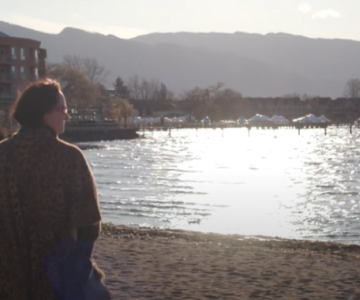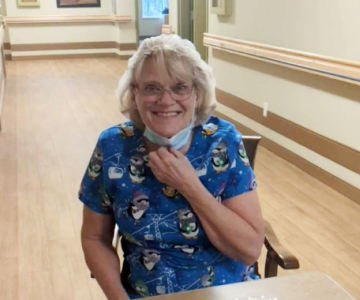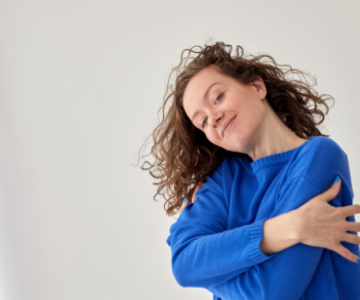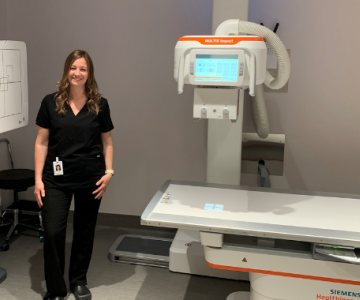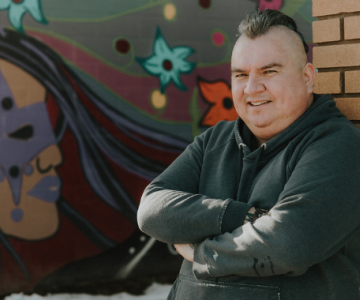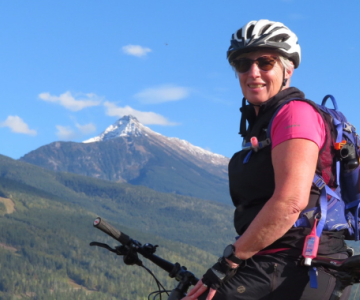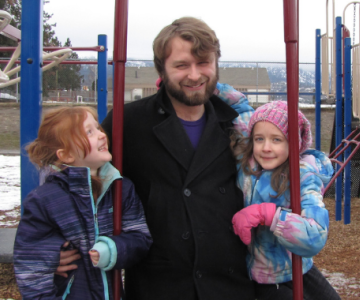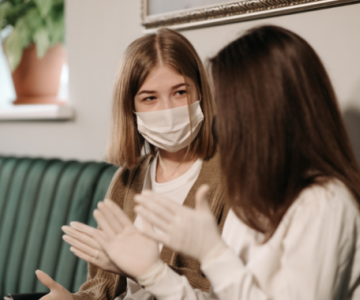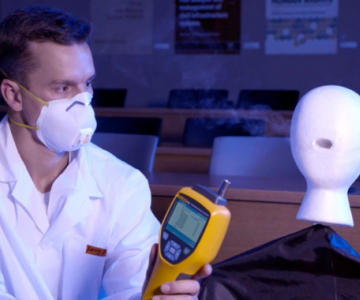Breadcrumb
Explore Stories
2 Minute Read
Health & Wellness
Ellen had never really spoken with anyone about her alcohol use. She credits the day treatment program for providing the safe place she needed to begin sharing, where she realized that she wasn’t alone.
2 Minute Read
Community & Culture
Sheila West has worked as a Patient Ambassador at Gillis House in Merritt for the last six months, but her history with the long-term care facility reaches back much further.
She started at Gillis House as a cook three-and-a-half years ago, and both her father and mother spent their final years there.
“I truly enjoy interacting with the residents and their visitors,” says Sheila. “And I love bringing a smile to their faces whenever I can.”
Some of her fondest memories are the reactions from residents to the personal touch she gave to meals and special occasion teas.
“I always keep busy and do my job to the best of my ability as well as helping others whenever I can.”
Sheila stays active outside of her work life, too. She loves to go metal detecting and magnet fishing and enjoys sewing and baking. She is looking forward to retiring someday, but says, “not too soon as I love my job!”
Proud parents of three, grandparents to 11 and great grandparents to three, Sheila and her husband just celebrated their 50th wedding anniversary in March.
We are IH is a recognition campaign to spotlight Interior Health employees and medical staff – through pictures and stories.
Name: Sheila Anne West
Job Title: Patient Ambassador
Years of Service: 3.5
Worksite: Gillis House
Community: Merritt
Ancestral Territory: Syilx
Favourite Quote: Treat everyone with respect and kindness.
Sheila’s nomination of Patricia (Patty) Ironstand keeps the We Are IH loop going:
“Patty is calm and professional in all situations and never hesitates to step in to help others if needed.” - Sheila West
Stay updated with careers at Interior Health
Facebook | Instagram | LinkedIn
1 Minute Read
Health & Wellness
“Positive body image isn’t believing your body LOOKS good.
It’s knowing that it IS good, regardless of how it looks.”
– Dr. Lindsay Kite
University of British Columbia doctorate student Kaylee Misener is an expert in positive body image. Her research focuses on clarifying what it means to have a positive body image, and how to get it.
5 tips to a positive body image
Appreciate how well your body functions for you. Body weight, shape and size are separate from your body image.
Keep good company – surround yourself with body positive people and influences.
What are you giving up? What would you rather be doing than feeling bad about your body? Focus on enjoyment, movement and functionality.
Self-compassion is a skill – be your own best friend and champion.
Self-compassion is self-kindness + common humanity + mindfulness, which helps us stay in the moment without evaluation.
Interested in learning more? Check out the video.
2 Minute Read
Health & Wellness
As a kid growing up in Ontario, Tarryl Hartling had a dream of living and working in the country.
She chased her dream, first to Whitehorse and onto Kamloops before accepting a position to work at the Chase Health Centre. The people and the community grounded her. Fourteen years later, she continues to work at the health centre as a registered technologist of radiology.
“I live in Chase and I'm invested in the people who live there,
because I know them on a personal level,” ~ Tarryl
“Everyone at the health centre works together well. Our end game is always the patients’ best interest and making sure they have the treatment they need."
If that need is an X-ray, patients will now receive it directly in Chase, in a newly renovated radiology room featuring a state-of-the-art machine that began serving patients on Jan. 31, 2022.
The $620,000 investment means people won't have to travel to another community for the service. The renovated radiology room also provides an improved patient experience for those needing an X-ray. The project also benefitted the entire health centre, as it required a full electrical upgrade to the building during the installation of the machine. This included a dedicated power supply to the ambulance bay for BC Emergency Health Services personnel.
The project was funded by Interior Health, but the nearby Chase and District Health Services Foundation had offered to raise money for the important purchase. As part of the project, and with the support of the Foundation, the radiology room had a complete makeover with new walls, paint and flooring as well as the addition of a power generator room and a new, ergonomically safe office.
“The community support from the Chase Foundation is amazing,” says Cathy Thibault, a now-retired Interior Health manager who supported the Chase Health Centre. “They were willing to ask, ‘how much this would cost?’ and ‘could they be part of the fundraising?’ We couldn’t do what we do without all of our partners."
It’s an example of an all-hands-on-deck approach at the Chase Health Centre that is echoed throughout the small community of some 3,000 people. Here, the people work together to support patients and their community.
Photo above: Registered technologist of radiology Tarryl Hartling with a new X-ray machine at the Chase Health Centre.
3 Minute Read
Community & Culture
Photo by Billie Jean Gabriel
Chris Bose’s artistic fingerprints are all over Kamloops.
Take a stroll and you will likely run into one of his murals. Maybe it’s the one at the Kamloops Aboriginal Friendship Society … or the one behind Immigrant Services … or the one at the Interior Health building downtown.
The Secwépemc and Nlaka’pamux artist, who calls Kamloops home, has been working with youth, adults and elders in Kamloops and across the country on community art projects for the past 15 years. But he’s never done an art project in a hospital.
Until now.
Chris has been contracted by the Royal Inland Hospital Foundation and Interior Health to lead an art project that represents the Aboriginal communities served by the hospital.
“I’m thrilled to be given this responsibility, to bring together so many different cultures into one artistic representation,” he says.
“There is incredible artwork represented in all of the Nations in this area. To have art that represents our people in the hospital, it means a lot. To be able to show the culture of the different Nations and help make the hospital more welcoming to our people, that is our goal.”
Royal Inland Hospital is located on the traditional territory of the Secwépemc Nation, one of seven First Nations that first inhabited the region served by Interior Health. The Dãkelh Dené, Tsilhqot’in, Northern St’at’imc, Nlaka’pamux and Syilx Nations also have communities that rely on the hospital, as do the Métis Nation and Inuit Peoples. All will be represented on the RIH Cultural Wall.
“This is an inclusive process and touching base with the different Nations has been positive,” says Chris.
“All of our communities are going through so much right now with the different emergencies and the heavy news about the residential schools. It’s just a tough time. I’m hoping this project can be a positive and help bring us together.”
Bose is connecting with members of each Nation, searching out culture and art, and looking for common themes as he begins the collaborative process of bringing several artistic elements into one final design.
“It’s such a beautiful and unique area and there are many different Indigenous communities that make us who we are. There is such beautiful art representing each Nation, such different styles. For the cultural wall we are working to create one innovative work of art,” said Chris.
The project is a collaboration between the Tk’emlúps te Secwépemc, the Secwépemc Health Caucus, the Two Rivers Métis Society, the Royal Inland Hospital Foundation and Interior Health.
“I became interested in this project because I love working on community-based art projects, murals, exhibitions, workshops, you name it!” he says. “Plus to have a permanent home in a care facility is even more amazing because I hope it’ll be a place of inspiration, of representation, of acknowledging we’re here and we’re honouring the past, present and future.”
The cultural wall will be located in the new nine-storey Phil & Jennie Gaglardi Tower in Kamloops, due to open in July 2022. The tower will have other pieces of art including representations of spirit animals on each of the floors, as selected by Secwépemc elders.
Certain patient rooms will also be able to host a smudging ceremony, if requested, for patients and families.
The patient care tower was designed with input from front-line health-care professionals to be elder and patient friendly and welcoming to people of all cultures and backgrounds. It will feature single-patient rooms throughout, new operating rooms, dedicated mental health and substance use space, obstetrics services and more. Once it opens to the public, work will begin on a major renovation to the emergency department and other areas of the hospital.
3 Minute Read
Community & Culture
After fifteen years in working in the travel industry, Maureen felt is was time for a career change. She returned to college in 2002 to take Health Information Management.
She completed her student practicum at Vernon Jubilee Hospital and has been with IH for 17 years now.
“During my practicum, I was offered a position in Health Information Management, so my husband and I packed our two cats and moved from New Westminster to Vernon.”
Through the course of her Interior Health career, Maureen has been involved in many projects, providing information crucial to the team.
“When the Polson Tower at Vernon Jubilee Hospital opened, I was on site opening day to solve problems and witness the culmination of five years of data support and planning – it was very exciting.”
Maureen is inspired knowing that the information she contributes helps to inform decision-making for the many programs and projects that Interior Health offers, which then make a genuine difference in people's lives.
Maureen was born in Mission, B.C. and grew up on a dairy farm east of Mission. Though she remembers that time fondly, she loves living in the Okanagan with its four seasons and easy access to the outdoors.
“I’m outdoorsy and love being in nature, whether that's hiking, trail running or cycling. I also love traveling to new and far-off places. I'm looking forward to the time when international travel will be safer and my husband and I can go on the cycling trip to Spain that we cancelled at the start of the pandemic.”
You can learn more about Maureen’s lifestyle on the ActiVernon YouTube channel, where she is know as Adventure Girl!
To keep the We Are IH loop going, Maureen nominates Cory Bendall
“I would like to nominate Cory Bendall. I've had the pleasure of working with Cory for several years providing information on Strokes in Interior Health. She is so incredibly passionate about improving stroke care and outcomes for people who experience a stroke.” - Maureen Mol
We are IH is a recognition campaign to spotlight Interior Health employees and medical staff – through pictures and stories.
Name: Maureen Mol
Job Title: Lead, Data Analytics - Acute
Years of Service: 17
Worksite: Community Health & Services Centre
Community: Kelowna
Ancestral Territory: Sylix Nation, Okanagan Interior Salish
Advice to live by: When you have a problem to solve, taking some time to go for a walk and think though the possibilities always helps.
Stay updated with careers at Interior Health
Facebook | Instagram | LinkedIn
2 Minute Read
Health & Wellness
A few weeks ago I took my daughters for their first COVID vaccine. It was a day I'd been looking forward to since vaccines first became available, and my wife and I were relieved to be finally able to provide our girls with more protection from this virus.
As any family with young children can attest, raising kids during a pandemic is stressful. It was more stressful before the children’s vaccine was available and it will be even less stressful after they get their second shot.
The restrictions have made our lives more complicated. And I'm feeling frustrated - with this virus and with those who don’t follow the health recommendations designed to keep the rest of us safe.
"Many of us have heard Omnicron may be 'less serious', but
we can't bring our guard down. People are still getting very sick
and dying from this. We already know that more health-care workers
are becoming ill and our health systems are struggling to care for
so many additional people."
The way I see it, I wear my mask, get vaccinated, social distance, etc. not only to protect myself and my family but also to protect my friends, and the people of my town. It is a small inconvenience to do these simple things to help protect everyone.
Helping your kids get a COVID-19 vaccine
When we told our kids about their upcoming vaccine, they had different reactions. My eldest child was calm and accepted it easily. She understood why she needed the vaccine and that it was helping everyone else. My younger child didn’t understand why she needed a vaccine - she was too overwhelmed at the thought of getting a needle.
When the day finally came for their vaccines, I was really impressed with how organized and supportive the staff at the clinic were.
I noticed right away that the health-care workers spoke directly to the children, rather than over them and to me. And when my youngest was upset and crying prior to the vaccine, they made suggestion (remove her coat, have her sit on my lap) to get her shot with the least amount of stress.
Afterwards, my kids got stickers, colouring sheets, and candy canes. When we were waiting the 15 minutes to leave, someone came by with sticky notes for the kids to put on positive messages for other children. My daughters liked doing that.
My advice to other parents? Get yourself and your kids vaccinated! It's the best way to keep your family safe.
About the author
Kirk Warkotsch lives in Kelowna with his wife and their two daughters.
2 Minute Read
Health & Wellness
Even helpers need help sometimes.
When I first arrived in Kelowna last year, the magnitude of the change in my work life and home life hit me pretty hard. Although it was a positive change for me, I realized in pretty short order, almost everything about this big new role in a new city was getting harder and harder.
Zoe, a Kelowna Mental Health team member, finds getting out in nature good for her mental wellness.My colleagues were noticing I wasn’t at my best and let our manager know.
I am so grateful for how skilful and kind my manager was. At times they shared stories about their own difficult times, and it really set my mind at ease. The relief I felt energized me to level up my self-care and get back on top of my stress.
Even though I’m a therapist by training, I needed that reminder that I can’t DIY everything in life.
I needed someone to say, ‘I see you’re struggling.’ Beyond that, I needed to let some help in!
Why? Because that’s how the best help works: some self-help added to letting others in. It is a proven recipe for success.
If you’re looking for help for yourself or someone you’re close to, check out our mental health resources.
About the author
Zoe uses her training as a mental health clinician now for Interior Health project work in the Okanagan. She says the support of the colleagues around her made all the difference when she recently experienced her own mental health concerns.
5 Minute Read
Research & Innovation
By understanding airborne disease transmission, UBC Okanagan researchers are seeking new ways to break the chain of infection
AIRBORNE. AIRFLOW. DROPLET. AEROSOL. Since the arrival of COVID-19, these words have become commonplace, integrated into everyday conversations as quickly as the virus spread globally. But what remains unclear—and requires further study—is the role of airflow, droplets and aerosols in the transmission of COVID-19 and other infectious diseases.
That’s where a team of researchers from UBC Okanagan’s Airborne Disease Transmission (ADT) Cluster of Research Excellence come in. The group is dedicated to studying airborne diseases, with the overall goal of reducing the transmission of respiratory infections.
“What we’ve learned from the COVID-19 pandemic is how much we don’t understand about airborne disease transmission,” explains Dr. Sunny Li, research and development lead for the cluster and an associate professor in UBCO’s School of Engineering.
He points to the fact that people originally thought surfaces were the major transmission route for COVID-19, and then only later realized that it is mainly transmitted through the air. Dr. Li says airflow dynamics as well as the interaction between airflow and particles are complicated, and as a result the movement of particles is hard to predict. However, one aspect is certain; when it comes to understanding airborne transmission, size matters.
“Think about the dust particles you see dancing in the sunlight,” he suggests. “Because they’re large, they don’t move far and eventually fall to the ground. Viruses, however, are incredibly small and they can stay suspended in the air for a very long time, similar to how pollen stays in the air. They’ll travel with the flow of air and that’s how they spread disease.”
“If we better understand airborne disease transmission,
we believe we can develop technology to
reduce its spread and infection.”
At 0.1 micrometres (μm) in diameter the coronavirus is ten times smaller than a dust particle, which in turn is 10 times smaller than a white blood cell. Such particles with sub-micrometre diameters are referred to as aerosols, while larger liquid particles—which can carry smaller particles within them like viruses—are usually called droplets.
The lack of information about the spread and infectivity of these small particles spurred Dr. Li to bring together a team of researchers from UBC Okanagan and Vancouver, and the University of Toronto. With expertise in multiphase flows, computational fluid dynamics as well as health and technology innovation, the group have formed the ADT research cluster, an interdisciplinary network of researchers focused on solving key challenges facing society. Armed with new insights from experimental investigation, computer modelling, clinical trials and manufacturing, the research cluster hopes to scrub airborne disease from the air.
“If we better understand airborne disease transmission, we believe we can develop technology to reduce its spread and infection,” Dr. Li says.
“Our research needs to go beyond the lab and into real-world scenarios,” he adds. “Because some data is collected in a controlled environment, it may be misleading. We need both real-world and lab data because they complement each other.”
Dr. Li is working with ADT research cluster co-lead Dr. Jonathan Little from the School of Health and Exercise Sciences, along with Dr. Joshua Brinkerhoff from the School of Engineering to test experimental protocols in classrooms, hospital rooms and dentist offices. There are now some promising preliminary results.
Air scavenger for health and dental procedures
With the support of a Mitacs Accelerate grant, an early ADT cluster project tested an airborne infection isolation and removal (AIIR) device developed by CareHealth Meditech for use in dental offices. With a similar look to an old-fashioned hairdryer, the device was designed to isolate and eliminate airborne droplets generated during dental procedures.
“Many dental procedures generate aerosols, or small droplets that may contain infectious particles,” says Dr. Li. “The key to control transmission is to scavenge them locally before they circulate through the room.”
The initial lab experiment involved performing dental procedures on a mannequin connected to a breathing simulator. Fluorescent powder was applied to the mannequin’s teeth and mouth to track the spread of potentially infectious particles. Ultraviolet light was then used to visualize droplet and aerosol creation and dispersal, along with the dentist’s exposure to the simulated pathogen.
According to Dr. Li, early findings have shown that the AIIR device is effective at removing large droplets and aerosols. While it’s currently being used in some dentist offices, the cluster is exploring ways to improve the design.
“Our team is looking at the device’s size and geometry in connection with its airflow dynamics and the dynamics of droplets and particles to see if we can make units that are more accurate and efficient,” says Dr. Li.
Building on this experimental design, the next step of the ADT research cluster was to evaluate a scavenging hood in a health-care setting, in partnership with the Pritchard Simulation Centre team at Interior Health. Instead of sitting in a dental chair, the mannequin was placed on a hospital bed and exhaled glowing fluorescent particles while a tube was inserted into its airway. Researchers assessed the ability of an airflow dome to remove potentially infectious aerosols while the intubation was performed, and the ease of working around this new piece of equipment.
“So far our findings are encouraging,” says Dr. Little, the health lead of the ADT research cluster. “The dome device efficiently removed the tagged droplets and inhibited their spread. Now we’d like to see how it will work during different medical procedures and how comfortable the health-care team feels around it. Adding a new piece of equipment into an already crowded operatory or procedures room can be tricky.”
Dr. Jared Baylis, medical director of simulation for Interior Health and the UBC Southern Medical Program, is enthusiastic about this new simulation research and the opportunity to collaborate. “This is exactly what our program is designed to do. We’re well set up and have the practical expertise to run the experiments proposed by the ADT research cluster. We look forward to supporting more of their research.” He notes that this research and ongoing studies are made possible thanks to funding from the Colin & Lois Pritchard Foundation Student Enhancement Fund.
Dr. Little adds that although getting the right fit for these scenarios may take some time, “we need to figure this out,” so that life-changing procedures are not delayed by rising infection rates.
This story was originally published by UBC Okanagan's News. Read the full story here.
-
Load More
Showing 396 of 677
STAY CONNECTED
Receive news and alert posts, and Stories@IH blog posts, right to your inbox!

